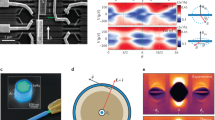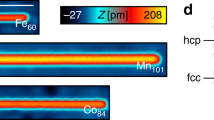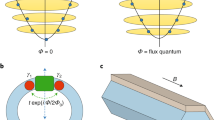Abstract
The interplay of superconductivity with non-trivial spin textures is promising for the engineering of non-Abelian Majorana quasiparticles. Spin–orbit coupling is crucial for the topological protection of Majorana modes as it forbids other trivial excitations at low energy but is typically intrinsic to the material1,2,3,4,5,6,7. Here, we show that coupling to a magnetic texture can induce both a strong spin–orbit coupling of 1.1 meV and a Zeeman effect in a carbon nanotube. Both of these features are revealed through oscillations of superconductivity-induced subgap states under a change in the magnetic texture. Furthermore, we find a robust zero-energy state—the hallmark of devices hosting localized Majorana modes—at zero magnetic field. Our findings are generalizable to any low-dimensional conductor, and future work could include microwave spectroscopy and braiding operations, which are at the heart of modern schemes for topological quantum computation.
This is a preview of subscription content, access via your institution
Access options
Access Nature and 54 other Nature Portfolio journals
Get Nature+, our best-value online-access subscription
$29.99 / 30 days
cancel any time
Subscribe to this journal
Receive 12 print issues and online access
$259.00 per year
only $21.58 per issue
Buy this article
- Purchase on Springer Link
- Instant access to full article PDF
Prices may be subject to local taxes which are calculated during checkout




Similar content being viewed by others
Data availability
The authors declare that the main data supporting the findings of this study are available within the article (main text, methods and Supplementary information). Extra data are available from the corresponding author on reasonable request.
Code availability
The codes used in this paper are available at https://github.com/Exopy.
References
Oreg, Y., Refael, G. & Von Oppen, F. Helical liquids and Majorana bound states in quantum wires. Phys. Rev. Lett. 105, 177002 (2010).
Lutchyn, R. M., Sau, J. D. & Das Sarma, S. Majorana fermions and a topological phase transition in semiconductor-superconductor heterostructures. Phys. Rev. Lett. 105, 077001 (2010).
Zhang, H. et al. Quantized Majorana conductance. Nature 556, 74–79 (2018).
Das, A. et al. Zero-bias peaks and splitting in an Al-InAs nanowire topological superconductor as a signature of Majorana fermions. Nat. Phys. 8, 887–895 (2012).
Albrecht, S. M. et al. Exponential protection of zero modes in Majorana islands. Nature 531, 206–209 (2016).
Nadj-Perge, S. et al. Observation of Majorana fermions in ferromagnetic atomic chains on a superconductor. Science 346, 602–607 (2014).
Deng, M. T. et al. Majorana bound state in a coupled quantum-dot hybrid-nanowire system. Science 354, 1557–1562 (2016).
Braunecker, B., Japaridze, G. I., Klinovaja, J. & Loss, D. Spin-selective peierls transition in interacting one-dimensional conductors with spin-orbit interaction. Phys. Rev. B 82, 045127 (2010).
Klinovaja, J., Stano, P. & Loss, D. Transition from fractional to Majorana fermions in Rashba nanowires. Phys. Rev. Lett. 109, 236801 (2012).
Klinovaja, J., Stano, P., Yazdani, A. & Loss, D. Topological superconductivity and Majorana fermions in RKKY systems. Phys. Rev. Lett. 111, 186805 (2013).
Kjaergaard, M., Wölms, K. & Flensberg, K. Majorana fermions in superconducting nanowires without spin-orbit coupling. Phys. Rev. B 85, 020503(R) (2012).
Egger, R. & Flensberg, K. Emerging dirac and Majorana fermions for carbon nanotubes with proximity-induced pairing and spiral magnetic field. Phys. Rev. B 85, 235462 (2012).
Klinovaja, J. & Loss, D. Giant spin-orbit interaction due to rotating magnetic fields in graphene nanoribbons. Phys. Rev. X 3, 011008 (2013).
Nadj-Perge, S., Drozdov, I. K., Bernevig, B. A. & Yazdani, A. Proposal for realizing Majorana fermions in chains of magnetic atoms on a superconductor. Phys. Rev. B 88, 020407 (2013).
Pientka, F., Glazman, L. I. & Von Oppen, F. Topological superconducting phase in helical Shiba chains. Phys. Rev. B 88, 155420 (2013).
Choy, T.-P., Edge, J. M., Akhmerov, A. R. & Beenakker, C. W. J. Majorana fermions emerging from magnetic nanoparticles on a superconductor without spin-orbit coupling. Phys. Rev. B 84, 195442 (2011).
Su, Z. et al. Mirage Andreev spectra generated by mesoscopic leads in nanowire quantum dots. Phys. Rev. Lett. 121, 127705 (2018).
Yokoyama, T., Eto, M. & Nazarov, Y. V. Josephson current through semiconductor nanowire with spin-orbit interaction in magnetic field. J. Phys. Soc. Jpn. 82, 054703 (2013).
San-Jose, P., Cayao, J., Prada, E. & Aguado, R. Majorana bound states from exceptional points in non-topological superconductors. Sci. Rep 6, 21427 (2016).
Keidel, F., Burset, P. & Trauzettel, B. Tunable hybridization of Majorana bound states at the quantum spin Hall edge. Phys. Rev. B 97, 075408 (2018).
Peñaranda, F., Aguado, R., San-Jose, P. & Prada, E. Quantifying wave-function overlaps in inhomogeneous Majorana nanowires. Phys. Rev. B 98, 235406 (2018).
Danon, J., Hansen, E. B. & Flensberg, K. Conductance spectroscopy on Majorana wires and the inverse proximity effect. Phys. Rev. B 96, 125420 (2017).
Liu, J., Potter, A., Law, K. & Lee, P. Zero-bias peaks in the tunneling conductance of spin-orbit-coupled superconducting wires with and without Majorana end-states. Phys. Rev. Lett. 109, 267002 (2012).
Rainis, D., Trifunovic, L., Klinovaja, J. & Loss, D. Towards a realistic transport modeling in a superconducting nanowire with Majorana fermions. Phys. Rev. B 87, 024515 (2013).
Liu, C.-X., Sau, J. D., Stanescu, T. D. & Das Sarma, S. Andreev bound states versus Majorana bound states in quantum dot-nanowire-superconductor hybrid structures: trivial versus topological zero-bias conductance peaks. Phys. Rev. B 96, 075161 (2017).
Cottet, A., Kontos, T. & Douçot, B. Squeezing light with Majorana fermions. Phys. Rev. B 88, 195415 (2013).
Van Woerkom, D. J. et al. Microwave spectroscopy of spinful Andreev bound states in ballistic semiconductor Josephson junctions. Nature Phys. 13, 876–881 (2017).
Väyrynen, J. I., Rastelli, G., Belzig, W. & Glazman, L. I. Microwave signatures of Majorana states in a topological Josephson junction. Phys. Rev. B 92, 134508 (2015).
Dartiailh, M. C., Kontos, T., Douçot, B. & Cottet, A. Direct cavity detection of Majorana pairs. Phys. Rev. Lett. 118, 126803 (2017).
Fatin, G. L., Matos-Abiague, A., Scharf, B. & Žutić, I. Wireless Majorana bound states: from magnetic tunability to braiding. Phys. Rev. Lett. 117, 077002 (2016).
Acknowledgements
We are indebted to B. Leridon for the SQUID measurements and to K. Bouzehouane for MFM measurements. We acknowledge J. Palomo, M. Rosticher, A. Pierret and A. Denis for technical support. L.C.C. acknowledges the support from a Foundation CFM-J.P. Aguilar grant. The devices were made within the consortium Salle Blanche Paris Centre. This work is supported by ERC Starting Grant CIRQYS and grants from Région Ile de France and the ANR FunTheme.
Author information
Authors and Affiliations
Contributions
M.M.D. set up the experiment, and L.C.C. made the devices and carried out the measurements with the help of T.K. L.C.C. and M.M.D. performed the analysis of the data with inputs from T.K. L.C.C. and M.R.D. carried out the fabrication, measurement and analysis of the control experiment. M.M.D., J.J.V. and L.E.B. contributed through early experiments and the development of the nanofabrication process. T.C. and F.M. contributed to the experimental aspects. M.C.D. developed the data acquisition software. S.R. and A.T. developed the magnetic texture process and carried out the magnetic characterization with M.M.D. and L.C.C. M.M.D., L.C.C., M.R.D., T.K. and A.C. carried out the theory for the ABS oscillations. M.M.D. studied the tight-binding model using a framework developed by M.C.D. with theoretical insight from A.C. T.K., M.M.D., L.C.C., M.R.D. and A.C. co-wrote the manuscript with inputs from all the authors.
Corresponding author
Ethics declarations
Competing interests
The authors declare no competing interests.
Additional information
Publisher’s note: Springer Nature remains neutral with regard to jurisdictional claims in published maps and institutional affiliations.
Supplementary information
Supplementary Information
Supplementary Notes 1–7, Figs. 1–16 and references.
Rights and permissions
About this article
Cite this article
Desjardins, M.M., Contamin, L.C., Delbecq, M.R. et al. Synthetic spin–orbit interaction for Majorana devices. Nat. Mater. 18, 1060–1064 (2019). https://doi.org/10.1038/s41563-019-0457-6
Received:
Accepted:
Published:
Issue Date:
DOI: https://doi.org/10.1038/s41563-019-0457-6
This article is cited by
-
Majorana corner states on the dice lattice
Communications Physics (2023)
-
1D Majorana Goldstinos and partial supersymmetry breaking in quantum wires
Communications Physics (2022)
-
Spin cross-correlation experiments in an electron entangler
Nature (2022)
-
Zero energy states clustering in an elemental nanowire coupled to a superconductor
Nature Communications (2022)
-
Fusion of Majorana bound states with mini-gate control in two-dimensional systems
Nature Communications (2022)



